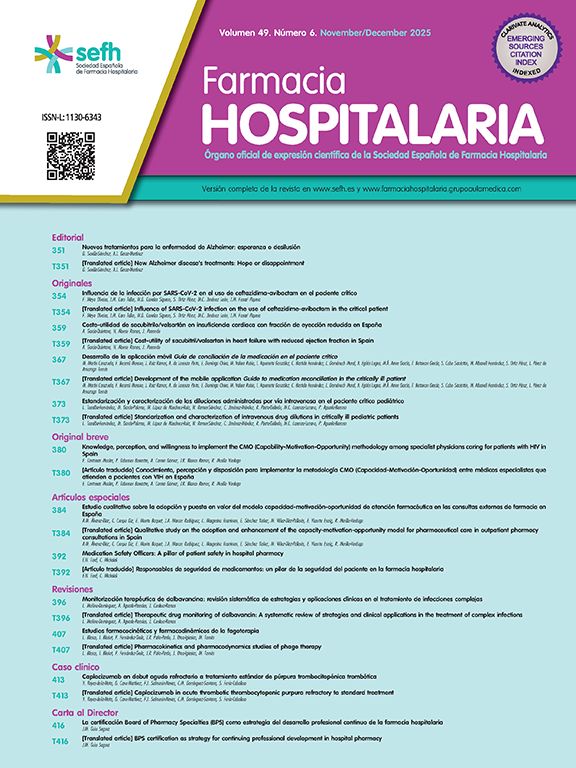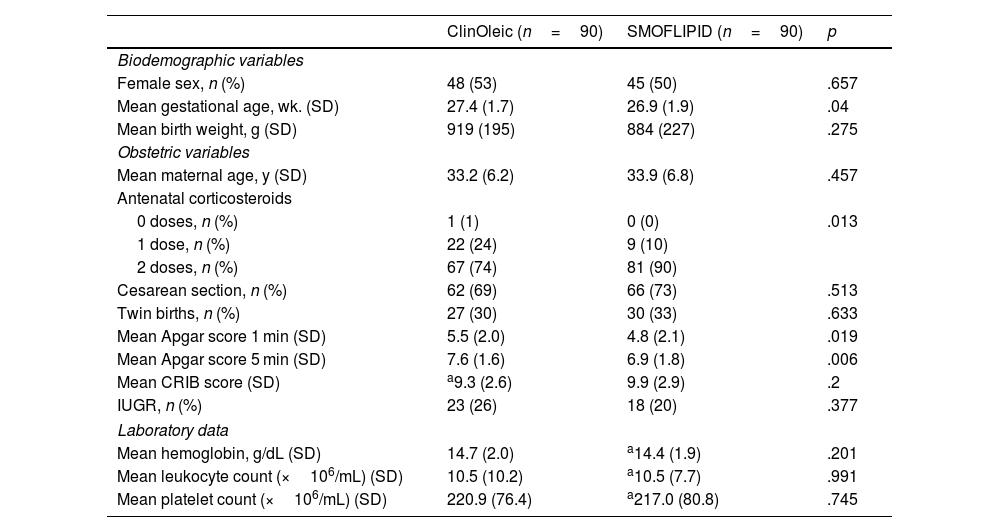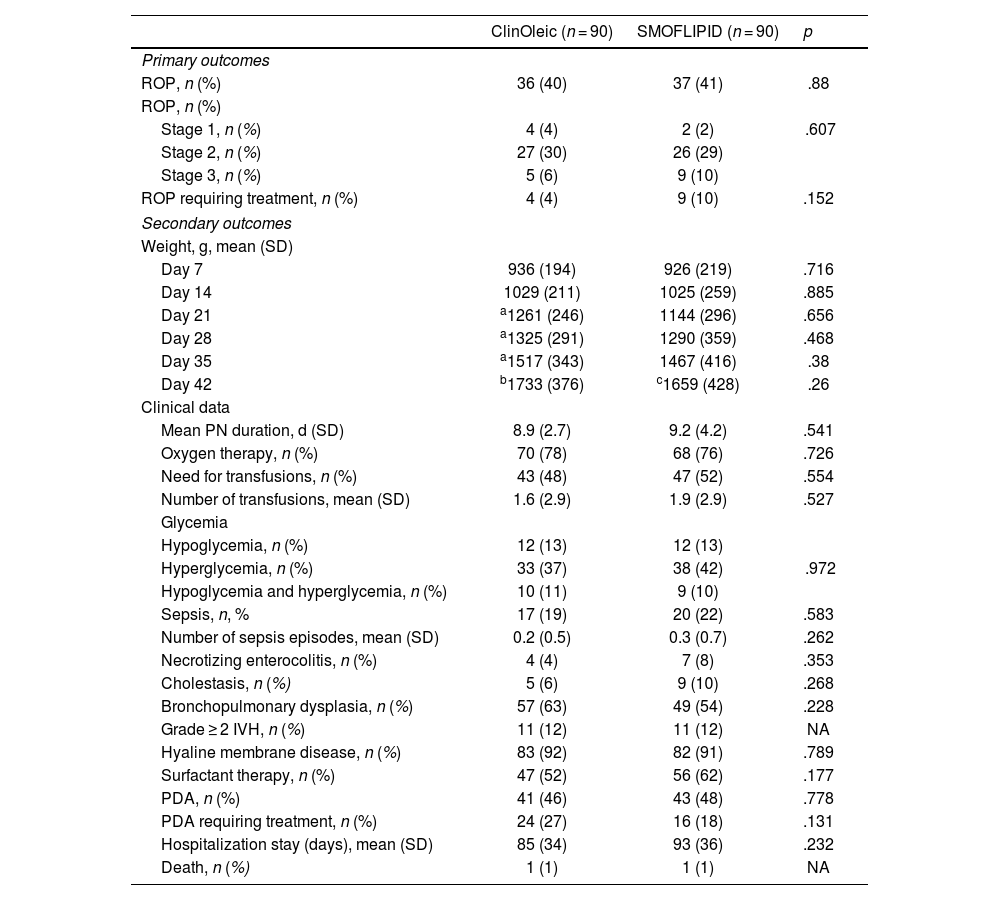The main aim was to compare the effects of 2 parenteral lipid emulsions on retinopathy of prematurity (ROP) incidence, severity, and need for treatment. Secondary aim was to compare the effect on weight gain in the first 6 weeks of life.
MethodsSingle-center, observational, retrospective study analyzing preterm infants with a gestational age (GA) <31 weeks and a birth weight <1251 g born between April 2015 and December 2018. The infants' medical records were reviewed to collect clinical data. Parenteral nutrition (PN) details were obtained from the hospital pharmacy database.
ResultsIn total, 180 patients were included: 90 received ClinOleic® and 90 received SMOFlipid®. No significant differences were observed for the incidence of ROP (40% in ClinOleic® group and 41% in SMOFlipid® group, p=.88) or ROP requiring treatment (4% and 10%, respectively, p=.152). Weekly weight gain was similar in the 2 groups.
ConclusionsThis study showed no difference between the 2 groups regarding ROP, ROP requiring treatment, or weekly weight gain in the first 6 weeks of life.
el objetivo principal fue comparar los efectos de 2 emulsiones de lípidos parenterales sobre la incidencia, la gravedad y la necesidad de tratamiento de la retinopatía del prematuro (ROP). El objetivo secundario fue comparar el efecto sobre el aumento de peso en las primeras 6 semanas de vida.
Métodosestudio retrospectivo, observacional, unicéntrico, que analizó recién nacidos prematuros con una edad gestacional <31 semanas y un peso al nacer <1.251 g, nacidos entre abril de 2015 y diciembre de 2018. Se revisaron las historias clínicas de los pacientes para recopilar los datos clínicos. Los datos de la nutrición parenteral se obtuvieron de la base de datos de la farmacia del hospital.
Resultadosen total se incluyeron 180 pacientes: 90 recibieron ClinOleic® y 90 SMOFlipid®. No se observaron diferencias significativas en la incidencia de ROP (40% en el grupo ClinOleic® y 41% en el grupo SMOFlipid®, p = 0,88) o de ROP que requería tratamiento (4 y 10% respectivamente, p = 0,152). El aumento de peso semanal fue similar en los 2 grupos.
Conclusioneseste estudio no muestra diferencias entre los 2 grupos en cuanto a ROP, ROP que requiere tratamiento o aumento de peso semanal en las primeras 6 semanas de vida.
Although SMOFlipid® is associated with neonatal growth rates and a reduction on the risk of cholestasis, reports on its effects on ROP and the need for ROP treatment are inconsistent.
We show no beneficials effects for SMOFlipid® on ROP incidence and the need for ROP treatment and no beneficials effects on weekly weight gain from birth to 6 weeks of life.
It is desirable that clinical trials be designed to investigate new strategies capable of preventing ROP or progression to more severe disease.
IntroductionRetinopathy of prematurity (ROP) is a multifactorial disease associated with preterm birth. Its incidence and severity are directly proportional to the degree of prematurity.1 Prevention of ROP is of utmost importance to avoid retinal detachment and blindness.
Docosahexaenoic acid (DHA) is an omega-3 fatty acid that is essential for the development of the brain. It accounts for 20% of all fatty acids in the retina. Endogenous DHA synthesis from the α-linoleic acid is inadequate to meet the neurodevelopment requirements of preterm infants, who in addition have practically no reserves as the acid accumulates in adipose tissue during the third trimester of pregnancy. The main source of DHA after birth for premature newborns is breast milk, but it is well known that many of them must be artificially nourished through parenteral nutrition in the first weeks of life.
Preventing progression to more severe disease is the best way to reduce associated morbidity in patients with ROP. Nutritional supplementation with omega-3 fatty acids contained in fish oil may modify the course of ROP. Nonetheless, while some studies have shown that intravenous fish oil-containing lipid emulsions have a protective effect against ROP incidence and severity,2,3 others have shown no such benefits.4–7
The main aim of this study is to compare the effects of ClinOleic® and SMOFlipid® as part of parenteral nutrition (PN) on ROP incidence, severity, and need for treatment. ClinOleic® is a lipid emulsion that contains 20% soybean oil and 80% olive oil, and SMOFlipid® contains 30% soybean oil, 30% MCT, 25% olive oil and 15% fish oil. The decision to switch from ClinOleic® to SMOFlipid® was based on the composition of the products. SMOFlipid® has an optimal omega-6/omega-3 ratio and contains the appropriate amount of alpha-tocopherol (200 mg/L), which acts as an antioxidant. Several studies have reported faster growth rates and a lower incidence of cholestasis with solutions containing SMOFlipid®.8–10
Secondary aims are to compare the effects of the 2 emulsions on weekly weight gain in the first 6 weeks of life and common clinical outcomes.
MethodsStudy design and populationWe designed a retrospective observational study of preterm infants born in Hospital Universitari Vall d'Hebron in Barcelona, Spain who were admitted to the neonatal intensive care unit between June 2015 and December 2018. We studied 2 periods: April 2015 to March 2017, when PN solutions contained ClinOleic®, and April 2017 to December 2018, when they contained SMOFlipid®. Lipid dosage was started at 0.5 g per kg body weight (BW) on day 1; this was increased by 0.5 g/kg BW every 24 h up to a maximum of 3.5 g/kg BW/d. Inclusion criteria were a gestational age at birth (GA) < 31 weeks at birth, a birth weight < 1.251 g, and initiation of PN following the hospital's nutrition protocol in the first 24 h of life. Patients included were stratified in 3 subgroups by GA (<27 weeks, 27–29 weeks, and >29 weeks). To be included, patients also had to have undergone at least 1 fundus examination as part of the hospital's ROP screening protocol. ROP was staged using the International Classification of Retinopathy of Prematurity criteria.11 The International Classification of the ROP establishes the bases to define the characteristics of retinopathy. When a retinopathy is diagnosed in a premature infant, the severity (stage), the extension, and the location of the retinopathy should be indicated and should define the characteristics of the vessels of the posterior pole. All this data establishes whether it is necessary to treat or continue carrying out serial controls of the fundus of the eye and their frequency. It usually affects both eyes, although it is sometimes asymmetrical or even unilateral. Stage was determined by the highest stage in either eye. Patients with congenital malformations were excluded.
The study was approved by the hospital's ethics and clinical research committee and the Spanish Agency for Medicines and Medical Devices (code: MJC-LIP-2017-01).
Biodemographic, obstetric, laboratory, and clinical dataThe following biodemographic and obstetric data were collected from the patients' clinical records: GA (in weeks), sex, birth weight, maternal age, use of antenatal corticosteroids, type of delivery, multiple gestation status, Apgar scores at 0, 5, and 10 min, Clinical Risk Index for Babies (CRIB) score, intrauterine growth retardation, and death. Hemoglobin, leukocyte, and platelet counts were recorded before initiation of PN. Weight was also recorded weekly up to week 6.
Additional clinical data collected were PN duration, need for oxygen therapy, need for and number of blood transfusions, hyperglycemia and hypoglycemia, confirmed sepsis and number of episodes, necrotizing enterocolitis, cholestasis, bronchopulmonary dysplasia, grade ≥2 intraventricular hemorrhage, hyaline membrane disease and need for surfactant therapy, patent ductus arteriosus and need for treatment (pharmacological with ibuprofen o surgical), and length of hospital stay.
Primary outcomes were the development of ROP and the need for treatment. Secondary outcomes including weight gain in the first 6 weeks of life and clinical variables were analyzed in both groups.
Statistical analysisSample size calculation, considering 95% confidence level and 85% power of test, for expected proportion values of ROP requiring intervention among 5%–15%, and 10% absolute difference between populations, was 175 subjects. Expecting 20% of not evaluable cases, 210 cases were considered to be identified. Finally, 180 were included.
Continuous variables are expressed using mean and SD and categorical variables as frequency and percentage. Means and proportions were compared using the t test and Chi-square test, respectively. Statistical analyses were performed in SPSS software (version 15.0, SPSS Inc. Chicago, Illinois, USA), with significance set at p≤.05.
ResultsOf the 214 infants identified, 34 were excluded: 31 because they had not undergone a fundus examination, 2 because of congenital malformations, and 1 because of a missing clinical record. Thus, after application of the inclusion and exclusion criteria, 180 infants remained: 90 in the ClinOleic® group and 90 in the SMOFlipid® group.
Mean GA was lower in infants who had received SMOFlipid® compared with ClinOleic® (26.9 vs 27.4 weeks, p=.04). Differences in lung maturation with antenatal corticosteroids were also significant, with 74% of patients in the ClinOleic® group achieving full maturation compared with 90% in the SMOFlipid® group (p=.013). Apgar scores at 1 and 5 min were significantly higher for ClinOleic® (p=.019 and p=.006, respectively). The differences observed for the rest of the biodemographic and obstetric variables were non-significant (Table 1).
Baseline biodemographic, obstetric, and laboratory variables.
| ClinOleic (n=90) | SMOFLIPID (n=90) | p | |
|---|---|---|---|
| Biodemographic variables | |||
| Female sex, n (%) | 48 (53) | 45 (50) | .657 |
| Mean gestational age, wk. (SD) | 27.4 (1.7) | 26.9 (1.9) | .04 |
| Mean birth weight, g (SD) | 919 (195) | 884 (227) | .275 |
| Obstetric variables | |||
| Mean maternal age, y (SD) | 33.2 (6.2) | 33.9 (6.8) | .457 |
| Antenatal corticosteroids | |||
| 0 doses, n (%) | 1 (1) | 0 (0) | .013 |
| 1 dose, n (%) | 22 (24) | 9 (10) | |
| 2 doses, n (%) | 67 (74) | 81 (90) | |
| Cesarean section, n (%) | 62 (69) | 66 (73) | .513 |
| Twin births, n (%) | 27 (30) | 30 (33) | .633 |
| Mean Apgar score 1 min (SD) | 5.5 (2.0) | 4.8 (2.1) | .019 |
| Mean Apgar score 5 min (SD) | 7.6 (1.6) | 6.9 (1.8) | .006 |
| Mean CRIB score (SD) | a9.3 (2.6) | 9.9 (2.9) | .2 |
| IUGR, n (%) | 23 (26) | 18 (20) | .377 |
| Laboratory data | |||
| Mean hemoglobin, g/dL (SD) | 14.7 (2.0) | a14.4 (1.9) | .201 |
| Mean leukocyte count (×106/mL) (SD) | 10.5 (10.2) | a10.5 (7.7) | .991 |
| Mean platelet count (×106/mL) (SD) | 220.9 (76.4) | a217.0 (80.8) | .745 |
CRIB, Clinical Risk Index for Babies; IUGR: intrauterine growth retardation.
Mean duration of PN was 8.9 days in the ClinOleic® group and 9.2 in the SMOFlipid® group. In the former, PN was administered for more than 7 days in 55 infants and for more than 14 days in 4 infants. Four infants in this group also required PN at some other point during admission. In the SMOFlipid® group, 46 and 7 infants received PN for more than 7 and 14 days, respectively. Twelve of the infants in this group required PN at another moment of hospitalization.
Primary outcomesNo differences were observed for ROP incidence (40% for ClinOleic® vs 41% for SMOFlipid®, p=.880), severity, or need for treatment (Table 2). The differences remained non-significant in the subgroup analyses by GA (<27 weeks, 27–29 weeks, and >29 weeks).
Clinical outcomes by study group.
| ClinOleic (n = 90) | SMOFLIPID (n = 90) | p | |
|---|---|---|---|
| Primary outcomes | |||
| ROP, n (%) | 36 (40) | 37 (41) | .88 |
| ROP, n (%) | |||
| Stage 1, n (%) | 4 (4) | 2 (2) | .607 |
| Stage 2, n (%) | 27 (30) | 26 (29) | |
| Stage 3, n (%) | 5 (6) | 9 (10) | |
| ROP requiring treatment, n (%) | 4 (4) | 9 (10) | .152 |
| Secondary outcomes | |||
| Weight, g, mean (SD) | |||
| Day 7 | 936 (194) | 926 (219) | .716 |
| Day 14 | 1029 (211) | 1025 (259) | .885 |
| Day 21 | a1261 (246) | 1144 (296) | .656 |
| Day 28 | a1325 (291) | 1290 (359) | .468 |
| Day 35 | a1517 (343) | 1467 (416) | .38 |
| Day 42 | b1733 (376) | c1659 (428) | .26 |
| Clinical data | |||
| Mean PN duration, d (SD) | 8.9 (2.7) | 9.2 (4.2) | .541 |
| Oxygen therapy, n (%) | 70 (78) | 68 (76) | .726 |
| Need for transfusions, n (%) | 43 (48) | 47 (52) | .554 |
| Number of transfusions, mean (SD) | 1.6 (2.9) | 1.9 (2.9) | .527 |
| Glycemia | |||
| Hypoglycemia, n (%) | 12 (13) | 12 (13) | .972 |
| Hyperglycemia, n (%) | 33 (37) | 38 (42) | |
| Hypoglycemia and hyperglycemia, n (%) | 10 (11) | 9 (10) | |
| Sepsis, n, % | 17 (19) | 20 (22) | .583 |
| Number of sepsis episodes, mean (SD) | 0.2 (0.5) | 0.3 (0.7) | .262 |
| Necrotizing enterocolitis, n (%) | 4 (4) | 7 (8) | .353 |
| Cholestasis, n (%) | 5 (6) | 9 (10) | .268 |
| Bronchopulmonary dysplasia, n (%) | 57 (63) | 49 (54) | .228 |
| Grade ≥ 2 IVH, n (%) | 11 (12) | 11 (12) | NA |
| Hyaline membrane disease, n (%) | 83 (92) | 82 (91) | .789 |
| Surfactant therapy, n (%) | 47 (52) | 56 (62) | .177 |
| PDA, n (%) | 41 (46) | 43 (48) | .778 |
| PDA requiring treatment, n (%) | 24 (27) | 16 (18) | .131 |
| Hospitalization stay (days), mean (SD) | 85 (34) | 93 (36) | .232 |
| Death, n (%) | 1 (1) | 1 (1) | NA |
IVH = intraventricular hemorrhage; NA = non-applicable; PDA = patent ductus arteriosus; PN = parenteral nutrition; ROP = retinopathy of prematurity.
In the subgroup of preterm infants with a GA <27 weeks, multiple gestations were more common among mothers of infants administered SMOFlipid® (33% vs 10% for ClinOleic®, p=.047) and ROP was more common in infants who had received SMOFlipid® (81% vs 60% for ClinOleic®, p=.104). Stage 2 ROP was also more common in the SMOFlipid® group (52% vs 40%). All cases of stage 3 ROP and ROP requiring treatment occurred in infants with a GA <27 weeks.
Secondary outcomesNo significant between-group differences were observed for weekly weight gain in the first 6 weeks or for any of the other clinical variables analyzed (Table 2).
Mean daily weight gain after 6 weeks was 19 g/d overall, 19.8 g/d in the ClinOleic® group (n=86), and 18.5 g/d in the SMOFlipid® group (n=84).
DiscussionThis is the first study conducted in Spain to compare the effects of the lipid emulsions ClinOleic® and SMOFlipid® on ROP incidence, severity, and need for treatment in preterm infants receiving PN.
ROP incidence was practically identical in the 2 treatment groups, and most cases were stage 2. Stage 3 ROP was more common in the SMOFlipid® group (9 cases vs 5 in the ClinOleic® group), but the difference was non-significant. Thirteen infants required treatment for ROP: 4 in the ClinOleic® group and 9 in the SMOFlipid® group. A trend towards a higher proportion of infants with stage 3 ROP and ROP requiring treatment was observed in those administered SMOFlipid®.
The clinical profile of the 2 treatment groups differed. Compared with infants in the ClinOleic® group, those who had received SMOFlipid® had a lower GA, were more likely to receive antenatal corticosteroid therapy, and had worse CRIB and Apgar scores. The nutritional profile suggests that patients in the SMOFlipid® group had worse clinical status and a greater risk of mortality or severe illness than those in the ClinOleic® group. The different patient profiles could explain the higher incidence of stage 3 ROP and greater need for treatment in patients who received SMOFlipid®.
Two studies by Pawlik and colleagues attributed the beneficial effects of fish oil on ROP to DHA.2,3 Fetal DHA requirements are estimated to be in the range of 40–60 mg/kg BW/d.12,13 SMOFlipid® 20% contains about 2% (w/w) DHA. A dosage of 2.5 g/kg BW/d of lipids thus would provide 50 mg of DHA/kg BW/d, which would cover practically all the requirements of preterm infants. The amount of DHA provided by SMOFlipid®, however, is lower in the first few days of life, and the potential effects of this insufficiency on morbidity are unknown.14
Just 4 studies have compared the effects of PN including SMOFlipid® and ClinOleic® on ROP and ROP requiring treatment in preterm infants. Unal et al.4 reported a lower, albeit non-significant, incidence of ROP (29.5% vs 32.5%) and stage ≥2 ROP (9.4% vs 11.7%) in infants administered SMOFlipid®. Zübariouglu et al.7 observed a higher, but non-significant, incidence of stage ≥2 ROP in infants administered ClinOleic® (34% vs 20.5%, p=.147). Two studies5,6 found no differences in the incidence and severity of ROP in preterm infants that received SMOFlipid® or ClinOleic®. None of these 4 studies found significant differences in the incidence of ROP, stage ≥2 ROP, or ROP requiring treatment between infants administered ClinOleic® or SMOFlipid®. Our results are consistent with these findings.
The effects of SMOFlipid® and soybean oil emulsions on ROP and the need for ROP treatment have been analyzed in more studies but the findings are inconsistent. Several studies have reported a lower incidence of ROP in patients administered SMOFlipid®, but no differences in ROP requiring treatment or stage ≥3 ROP.14–16 Three other studies17–19 reported lower ROP incidence in the SMOFlipid® group, however, might be due to the longer PN duration in the soybean oil emulsions group or the older GA in SMOFlipid® group.
In the clinical trial by Vlaardingerbroek et al.,8 stage ≥3 ROP was more common in patients who received Intralipid® (4% vs 0% for SMOFlipid®, p=.494). D'Ascenzo et al.20 compared plasma fatty acids in preterm infants who received SMOFlipid® and Intralipid®. Infants administered SMOFlipid® had higher plasma concentrations of DHA and eicosapentaenoic acid, but there were no cases of stage ≥3 ROP in any of the groups. Another 2 studies also found non-significant differences in the incidence of stage ≥3 ROP according to the use of PN including SMOFlipid® or Intralipid®.12,21 Similar findings for ROP and ROP requiring treatment have been reported in several clinical trials.22–24 On the other hand, Gharehbaghi et al.25 reported a significantly lower incidence of stage 3 ROP in patients who received SMOFlipid®.
Choudhary et al.,26 on comparing 2 periods like us, found a higher incidence of ROP among preterm infants who received SMOFlipid® compared with Intralipid® (54% vs 39%, p=.03). Qian et al.27 observed higher rates of ROP in preterm infants who received SMOFlipid® versus Lipofundin® (60.1% vs 47.4%, p=.19). ROP rates were also higher in infants on SMOFlipid® compared with Intralipid® in the studies by Uberos et al.28 and by Jackson et al.29 Finally, Thanhaeuser et al.30 reported that preterm infants on SMOFlipid® with a birth weight <750 g at 12 months of corrected GA had a higher incidence of ROP than infants with the same profile on Intralipid® (85.7% vs 70%). The need for treatment, however, was higher in the Intralipid® group (20% vs 17%).
Our study compares the effects of different types of lipid emulsions in PN on weekly weight gain from birth to 6 weeks of life. Our results are consistent with those reported in the clinical trial by Hsiao et al.,24 where infants on SMOFlipid® gained a mean of 18.42 g/d. Other 2 studies8,26 reported a greater weight gain for SMOFlipid® compared with Intralipid®.
The main limitation of this study is its single-center, observational, retrospective design. Furthermore, the DHA provided by the enteral diet has not been quantified, which could modify the results obtained. Our findings may also have been influenced by improvements to neonatal care over the study period.
In conclusion, this retrospective study showed the lack of beneficial effects of SMOFlipid® compared with ClinOleic® on ROP incidence and severity. Multiple factors influence clinical outcomes in preterm infants, making it very difficult to discern the effects of different types of nutritional lipid emulsions using observational data from retrospective cohorts. A beneficial effect for SMOFlipid® on other clinical outcomes in preterm infants cannot be ruled out based on our findings.
Statement of EthicsThe study was approved by the hospital's ethics and clinical research committee and the Spanish Agency for Medicines and Medical Devices (code: MJC-LIP-2017-01).
Author contributionsMª José Cabañas Poy: data collection, study design, interpretation of analysis and manuscript writing; Bruno Montoro Ronsano: analysis and interpretation; Félix Castillo Salinas: data collection; remaining authors: manuscript revision. All the authors approved the final version of the manuscript.
Funding sourcesNo specific funding was received for this study from agencies in the public, commercial, or not-for-profit sectors.
Ethical considerationsThe authors declare that they followed their institutions' protocols to access to the patients data and that was done with the unique purpose of the scientific investigation and scientific disclosure.
CRediT authorship contribution statementMª José Cabañas Poy: Writing – review & editing, Writing – original draft, Supervision, Methodology, Investigation, Formal analysis, Data curation, Conceptualization. José Bruno Montoro Ronsano: Writing – original draft, Methodology, Formal analysis. Félix Castillo Salinas: Writing – original draft, Formal analysis, Data curation. Nieves Martín-Begué: Writing – original draft, Formal analysis, Data curation. Susana Clemente Bautista: Writing – original draft, Formal analysis, Conceptualization. Mª Queralt Gorgas Torner: Writing – review & editing, Writing – original draft, Methodology.







